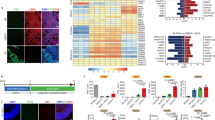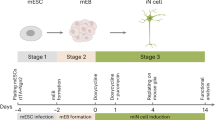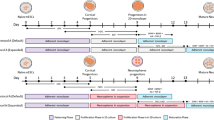Abstract
Pluripotent or multipotent stem cells isolated from human embryos or adult central nervous system (CNS) may provide new neurons to ameliorate neural disorders. A major obstacle, however, is that the majority of such cells do not differentiate into neurons when grafted into non-neurogenic areas of the adult CNS. Here we report a new in vitro priming procedure that generates a nearly pure population of neurons from fetal human neural stem cells (hNSCs) transplanted into adult rat CNS. Furthermore, the grafted cells differentiated by acquiring a cholinergic phenotype in a region-specific manner. This technology may advance stem cell–based therapy to replace lost neurons in neural injury or neurodegenerative disorders.
This is a preview of subscription content, access via your institution
Access options
Subscribe to this journal
Receive 12 print issues and online access
$209.00 per year
only $17.42 per issue
Buy this article
- Purchase on Springer Link
- Instant access to full article PDF
Prices may be subject to local taxes which are calculated during checkout







Similar content being viewed by others
References
Thomson, J.A. et al. Embryonic stem cell lines derived from human blastocysts. Science 282, 1145–1147 (1998).
Shamblott, M.J. et al. Derivation of pluripotent stem cells from cultured human primordial germ cells. Proc. Natl. Acad. Sci. USA 95, 13726–13731 (1998).
Villa, A., Snyder, E.Y., Vescovi, A. & Martinez-Serrano, A. Establishment and properties of a growth factor-dependent, perpetual neural stem cell line from the human CNS. Exp. Neurol. 161, 67–84 (2000).
Carpenter, M.K. et al. In vitro expansion of a multipotent population of human neural progenitor cells. Exp. Neurol. 158, 265–278 (1999).
Svendsen, C.N. et al. A new method for the rapid and long term growth of human neural precursor cells. J. Neurosci. Methods 85, 141–152 (1998).
Uchida, N. et al. Direct isolation of human central nervous system stem cells. Proc. Natl. Acad. Sci. USA 97, 14720–14725 (2000).
Vescovi, A.L. et al. Isolation and cloning of multipotential stem cells from the embryonic human CNS and establishment of transplantable human neural stem cell lines by epigenetic stimulation. Exp. Neurol. 156, 71–83 (1999).
Roy, N.S. et al. In vitro neurogenesis by progenitor cells isolated from the adult human hippocampus. Nat. Med. 6, 271–277 (2000).
Johansson, C.B., Svensson, M., Wallstedt, L., Janson, A.M. & Frisen, J. Neural stem cells in the adult human brain. Exp. Cell Res. 253, 733–736 (1999).
Palmer, T.D. et al. Cell culture. Progenitor cells from human brain after death. Nature 411, 42–43 (2001).
Flax, J.D. et al. Engraftable human neural stem cells respond to developmental cues, replace neurons, and express foreign genes. Nat. Biotechnol. 16, 1033–1039 (1998).
Brustle, O. et al. Chimeric brains generated by intraventricular transplantation of fetal human brain cells into embryonic rats. Nat. Biotechnol. 16, 1040–1044 (1998).
Reubinoff, B.E. et al. Neural progenitors from human embryonic stem cells. Nat. Biotechnol. 19, 1134–1140 (2001).
Zhang, S.C., Wernig, M., Duncan, I.D., Brustle, O. & Thomson, J.A. In vitro differentiation of transplantable neural precursors from human embryonic stem cells. Nat. Biotech. 19, 1129–1133 (2001).
Suhonen, J.O., Peterson, D.A., Ray, J. & Gage, F.H. Differentiation of adult hippocampus-derived progenitors into olfactory neurons in vivo. Nature 383, 624–627 (1996).
Shihabuddin, L.S., Horner, P.J., Ray, J. & Gage, F.H. Adult spinal cord stem cells generate neurons after transplantation in the adult dentate gyrus. J. Neurosci. 20, 8727–8735 (2000).
Fricker, R.A. et al. Site-specific migration and neuronal differentiation of human neural progenitor cells after transplantation in the adult rat brain. J. Neurosci. 19, 5990–6005 (1999).
Svendsen, C.N. et al. Long-term survival of human central nervous system progenitor cells transplanted into a rat model of Parkinson's disease. Exp. Neurol. 148, 135–146 (1997).
Sheen, V.L., Arnold, M.W., Wang, Y. & Macklis, J.D. Neural precursor differentiation following transplantation into neocortex is dependent on intrinsic developmental state and receptor competence. Exp. Neurol. 158, 47–62 (1999).
Cao, Q.L. et al. Pluripotent stem cells engrafted into the normal or lesioned adult rat spinal cord are restricted to a glial lineage. Exp. Neurol. 167, 48–58 (2001).
Jessell, T.M. Neuronal specification in the spinal cord: inductive signals and transcriptional codes. Nat. Rev. Genet. 1, 20–29 (2000).
Anderson, D.J. Stem cells and pattern formation in the nervous system: the possible versus the actual. Neuron 30, 19–35 (2001).
Caldwell, M.A. et al. Growth factors regulate the survival and fate of cells derived from human neurospheres. Nat. Biotechnol. 19, 475–479 (2001).
Bonfanti, L., Gritti, A., Galli, R. & Vescovi, A.L. in Stem Cells and CNS Development (ed. Rao, M. S.) 49–70 (Humana Press, Totowa, New Jersey, 2001).
Schmitz, H.D. & Bereiter-Hahn, J. GFP associates with microfilaments in fixed cells. Histochem. Cell Biol. 116, 89–94 (2001).
Wu, P., Ye, Y. & Svendsen, C.N. Transduction of human neural progenitor cells using recombinant adeno-associated viral vectors. Gene Ther. 9, 245–255 (2002).
Ostenfeld, T. et al. Human neural precursor cells express low levels of telomerase in vitro and show diminishing cell proliferation with extensive axonal outgrowth following transplantation. Exp. Neurol. 164, 215–226 (2000).
Ying, Q.L., Nichols, J., Evans, E.P. & Smith, A.G. Changing potency by spontaneous fusion. Nature 416, 545–548 (2002).
Terada, N. et al. Bone marrow cells adopt the phenotype of other cells by spontaneous cell fusion. Nature 416, 542–545 (2002).
Shihabuddin, L.S., Ray, J. & Gage, F.H. Stem cell technology for basic science and clinical applications. Arch. Neurol. 56, 29–32 (1999).
Whittemore, S.R., Morassutti, D.J., Walters, W.M., Liu, R.H. & Magnuson, D.S.K. Mitogen and substrate differentially affect the lineage restriction of adult rat subventricular zone neural precursor cell populations. Exp. Cell Res. 252, 75–95 (1999).
Kan, M.K. et al. An essential heparin-binding domain in the fibroblast growth-factor receptor kinase. Science 259, 1918–1921 (1993).
Fannon, M., Forsten, K.E. & Nugent, M.A. Potentiation and inhibition of bFGF binding by heparin: a model for regulation of cellular response. Biochemistry 39, 1434–1445 (2000).
Song, H., Stevens, C.F. & Gage, F.H. Astroglia induce neurogenesis from adult neural stem cells. Nature 417, 39–44 (2002).
Isacson, O. & Deacon, T. Neural transplantation studies reveal the brain's capacity for continuous reconstruction. Trends Neurosci. 20, 477–482 (1997).
Bottenstein, J.E. & Sato, G.H. Growth of a rat neuroblastoma cell line in serum-free supplemented medium. Proc. Natl. Acad. Sci. USA 76, 514–517 (1979).
Messam, C.A., Hou, J. & Major, E.O. Coexpression of nestin in neural and glial cells in the developing human CNS defined by a human-specific anti-nestin antibody. Exp. Neurol. 161, 585–596 (2000).
Coggeshall, R.E. A consideration of neural counting methods. Trends Neurosci. 15, 9–13 (1992).
Acknowledgements
The authors thank C.N. Svendsen and W.D. Willis for critical reading. We are also grateful to Y. Ye and Z. Chen for technical assistance, as well as to B.M. Walters for manuscript preparation. This work was supported by the John Sealy Memorial Endowment Fund (P.W.), Mission Connect of the Institute for Rehabilitation and Research Foundation (P.W.) and National Institute on Drug Abuse (L.M.H.).
Author information
Authors and Affiliations
Corresponding author
Ethics declarations
Competing interests
The University of Texas Medical Branch has submitted a patent application covering the method to produce region-specific neurons from human neural stem cells.
Rights and permissions
About this article
Cite this article
Wu, P., Tarasenko, Y., Gu, Y. et al. Region-specific generation of cholinergic neurons from fetal human neural stem cells grafted in adult rat. Nat Neurosci 5, 1271–1278 (2002). https://doi.org/10.1038/nn974
Received:
Accepted:
Published:
Issue Date:
DOI: https://doi.org/10.1038/nn974
This article is cited by
-
Human neural stem cell-derived neuron/astrocyte co-cultures respond to La Crosse virus infection with proinflammatory cytokines and chemokines
Journal of Neuroinflammation (2018)
-
Estrogen promotes the brain metastatic colonization of triple negative breast cancer cells via an astrocyte-mediated paracrine mechanism
Oncogene (2016)
-
Short-Term Differentiation of Glioblastoma Stem Cells Induces Hypoxia Tolerance
Neurochemical Research (2016)
-
Apoptotic and cytotoxic effect of Semecarpus anacardium Linn nut milk extract on MCF-7 breast cancer cells
Comparative Clinical Pathology (2015)
-
Neural stem cells for spinal cord repair
Cell and Tissue Research (2012)



